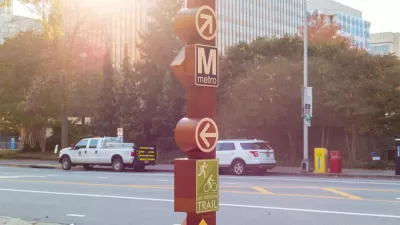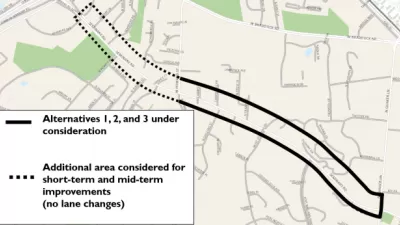When it comes to intersections, adding more complexity can do more harm than good, according to a recent, detailed post on Greater Greater Washington.
Ben Ross decries the growing complexity of traffic signals at intersections all over the country, which might be better at distracting drivers than they are at directing them.
Ross selects the "intersection of doom" in Arlington—where Mount Vernon Trail turns into Custis Trail at the foot of the Key Bridge in Arlington—as a case study of unnecessary complexity in traffic signals and intersection design. There, explains Ross, "Drivers must simultaneously watch for cars coming from the left, cyclists and pedestrians entering the crosswalk from the right, and an overhead signal that went in in January that flashes a no-right-turn graphic for a few seconds during the leading pedestrian interval." Moreover, "the no-right-turn graphic is hard to see in bright light, and it is flanked by highly visible signs that seem to say turns are allowed."
According to Ross the arrangement of this intersection is common around American cities—the only thing remarkable about it is the large number of bikes and pedestrians travelling through the intersection.
The article goes on to discuss larger concepts that inform an understanding of how intersections like this fail to meet a goal of reliably keeping roads safe. Ross notes especially that two concepts are missing from traffic engineering guidelines: redundancy and parsimony. "Redundancy means backups for missed signals and improper actions. Parsimony means signals aren't excessively complex."
FULL STORY: Complex traffic signals make streets less safe

Planetizen Federal Action Tracker
A weekly monitor of how Trump’s orders and actions are impacting planners and planning in America.

Maui's Vacation Rental Debate Turns Ugly
Verbal attacks, misinformation campaigns and fistfights plague a high-stakes debate to convert thousands of vacation rentals into long-term housing.

Restaurant Patios Were a Pandemic Win — Why Were They so Hard to Keep?
Social distancing requirements and changes in travel patterns prompted cities to pilot new uses for street and sidewalk space. Then it got complicated.

Charlottesville Temporarily Has No Zoning Code
A judge ordered the Virginia city to throw out its newly revised zoning code, leaving permitting for new development in legal limbo.

In California Battle of Housing vs. Environment, Housing Just Won
A new state law significantly limits the power of CEQA, an environmental review law that served as a powerful tool for blocking new development.

Boulder Eliminates Parking Minimums Citywide
Officials estimate the cost of building a single underground parking space at up to $100,000.
Urban Design for Planners 1: Software Tools
This six-course series explores essential urban design concepts using open source software and equips planners with the tools they need to participate fully in the urban design process.
Planning for Universal Design
Learn the tools for implementing Universal Design in planning regulations.
Heyer Gruel & Associates PA
JM Goldson LLC
Custer County Colorado
City of Camden Redevelopment Agency
City of Astoria
Transportation Research & Education Center (TREC) at Portland State University
Jefferson Parish Government
Camden Redevelopment Agency
City of Claremont





























